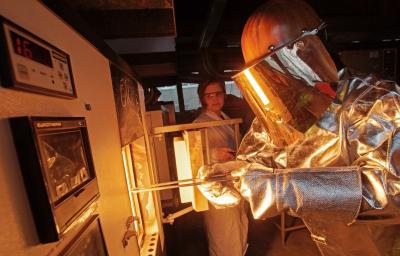
Making glass-ceramics at Jena University. Credit: Jan-Peter Kasper, FSU.
James Bond fans know well the villain Jaws, a character in The Spy Who Loved Me and Moonraker. Jaws wasn’t concerned about appearance as long as his powerful steel teeth could be sunk into a foe.
But, finding strong and natural-appearing materials for artificial teeth for use in bridges and dentures is a big concern for dentistry professionals, and a group from the Otto Schott Institute for Glass Chemistry at the Friedrich Schiller University of Jena (Germany) think their new nanocrystal-based approach to glass-ceramic dental materials provides a superior solution.
Glass–ceramic materials have been known for decades as a way for engineers and researchers to combine the best of possible characteristics of the glass and ceramic worlds. The general process used is to carefully controlling the growth of crystals during the reheating of glass, which is typically seeded with nucleating additives. The degree of crystallization is controlled through the heating process and can range from partial to full crystallization. The most familiar glass–ceramic application probably is the ubiquitous translucent “glass” stovetop that provides a glass-like appearance while retaining the strength and thermodynamic properties of a ceramic.
The Jena group, led by Christian Rüssel, a professor at the university, recently experimented with glass–ceramic materials based on magnesium-, aluminum- and silicon oxide to achieve a high-strength product. They also used different concentrations of zirconia as a nucleating agent. They also experimented with doping some of the compositions with ZnO or P2O5.
In a news release from the school, Rüssel reports, “We achieve a strength five-times higher than with comparable denture ceramics available today.”
They say their first step was to melt the starting materials around 1,500°C. The glass is cooled and finely ground. They then melted and cooled it again. Finally, nanocrystals are generated by controlled heating to about 1,000°C. “This procedure determines the crystallization crucial for the strength of the product,” Rüssel explains.
Rüssel’s group found that by varying the amount of zirconia, they could create colorless glass–ceramics that ranged from transparent to opaque. Thus, the materials could be fine-tuned to display some of the partial translucency of the natural enamel in teeth. The size of the formed nanocrystals is apparently key. Rüssel says the nanocrystals are too small to strongly disperse light, and thus can appear translucent.
As far as strength goes, a paper by Rüssel et al. published in Journal of Biomedical Materials Research (doi:10.1002/jbm.b.31972) reports that they obtained a bending strength of 475 MPa by annealing the material at 1,000°C for three hours. They also obtained a microhardness up to 13.3 GPa and of the fracture toughness up to 2.7 MPa m1/2.
The Jena glass chemists didn’t start off looking for new dental materials. In fact, the dental idea sprang up while they were working on high-density ceramics for applications in other fields, such as materials for higher efficiency computer hard drives. Once Rüssel and the others began to understand some of the optical characteristics of some of the materials they were testing, they realized, according to Rüssel, that “an additional field of application is opening up for these materials in dentistry.”
007 trivia experts may remember that Jaws turned from bad guy to James Bond ally in Moonraker, and even fell in love. Too bad for Jaws that the Jena glass-ceramics weren’t around to allow the writers to create a more attractive happy ending for him and his bride-to-be.
– – –
Editor’s note: I have been absent from these pages for many weeks due to an unexpected medical problem.
I am on the mend now and making daily progress. Many thanks go to Eileen De Guire and others on the ACerS staff who are helping with the posting and editing until I am back to 100%.
